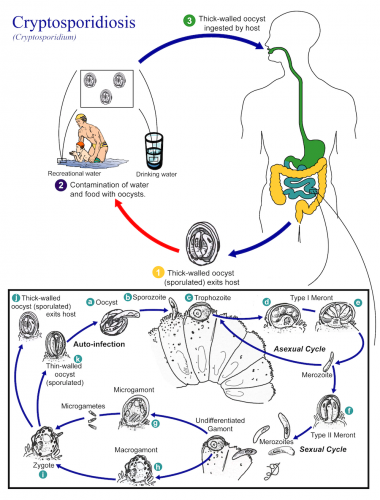Water Treatment 101: Cryptosporidium

Research backcountry water treatment and you’re sure to be warned about cryptosporidium or “crypto.” And for good reason. This microscopic protozoan parasite is one of the most common causes of waterborne disease in humans in the United States. Like the parasite giardia, crypto is found in water sources worldwide, and affects individuals differently. Fortunately, the disease it causes is rarely life-threatening in healthy adults. In fact, some 80% of the U.S. population has had cryptosporidiosis at some time, according to the FDA. Still, its symptoms are nasty enough that you’ll want to take strides to avoid it on your next backpacking trip.
A hardy single-celled organism, cryptosporidium lives in the intestines of infected humans and animals and is shed in the stool. It’s protected by a robust outer shell, allowing it to survive for long periods of time even in harsh environments, like icy backcountry streams. Crypto is highly resistant to chlorine-based disinfectants, but its large size (microscopically speaking) makes it easy to remove with a microfilter rated for protozoa.
At MSR, we believe the likelihood of contracting cryptosporidium from North American wilderness water isn’t especially high. But because there’s no way to know for sure, we recommend always filtering your water, or using a combination of treatments, to eliminate the risk. The same body of water may be contaminated with crypto in one section, while nearly absent of it in another.
How is Crypto spread?
Cryptosporidium is spread through the feces of an infected person or animal. As such, it can end up in water sources, the soil, or on surfaces contaminated with that fecal matter. Being diligent about good hygiene while camping and backpacking will help prevent you from accidently swallowing the parasite.

It’s during the most infectious stage of the microorganism’s life cycle, called oocysts, that crypto can be passed from person to person or animal to human. Water sources near grazing areas are typically higher risk for crypto, but even pristine wilderness zones can see contamination from deer, goats, sheep, rodents or other animals.
These oocysts are protected by that outer shell, which allows them to endure outside a host for up to 18 months. They’re also resilient to stomach acids. And even after symptoms subside, they can be shed in bowel movements for months. Crypto is not killed by freezing—and it’s highly resistant to purification tablets.
What happens when you get it?
It can take as few as 10 to 100 oocysts to make you sick. Once contracted, these oocysts burrow into the walls of your small intestine—and multiply. As your body reacts, symptoms can emerge in an average of 2 to 7 days. In healthy adults, symptoms usually last a week or two and can come in cycles.
Those with weak immune systems are at a much higher risk for health complications, and without proper treatment, the infection can become life threatening. Some people can be exposed to crypto and experience no symptoms at all. The strength of your immune system and the amount of oocysts you ingest impact your reaction to the illness.
Symptoms:
Cryptosporidiosis typically causes terrible bouts of watery diarrhea. An infected person can pass 3 to 6 liters of watery stool per day, making dehydration a real concern.
Symptoms include:
Stomach cramps Dehydration Nausea
Vomiting Fever Weight loss
Diagnosis:
Like giardia, which produces similar symptoms, cryptosporidium is usually diagnosed through a stool sample. An acid-staining test under a microscope can reveal the presence of cryptosporidium oocycts in cells taken from the stool.
Treatment:
Replacing the fluids and electrolytes lost through diarrhea to prevent dehydration is often the ticket for healthy adults as symptoms pass. While there is no effective drug to treat cryptosporidiosis itself, the anti-parasitic drug Nitazoxanide can be prescribed to treat diarrhea.
But individuals with weakened immune systems are much more susceptible to the complications from dehydration and should seek medical attention immediately.
Removal:
Cryptosporidium cannot be killed or inactivated with most chemical treatments, including iodine and chlorine tablets. (Chlorine-dioxide has been approved but it takes up to 4 hours.) Like all waterborne pathogens, boiling destroys the parasite, but this can use up a great deal of fuel over the course of a trip. Instead, MSR recommends filtration for removing crypto from your backcountry water, especially if that water contains dirt or other particulates, which can shield the microbes from UV light treatments.
The U.S. EPA calls for removal or inactivation of 99.9% of cryptosporidium oocysts in drinking water. All MSR microfilters and purifiers meet this standard, including the MiniWorks, SweetWater and AutoFlow systems.
Crypto may be one of the most common causes of waterborne illness, but it’s not the only potential threat swimming in wilderness water. The decision to treat water is yours to make, but MSR recommends filtering or purifying all water collected in the backcountry.
